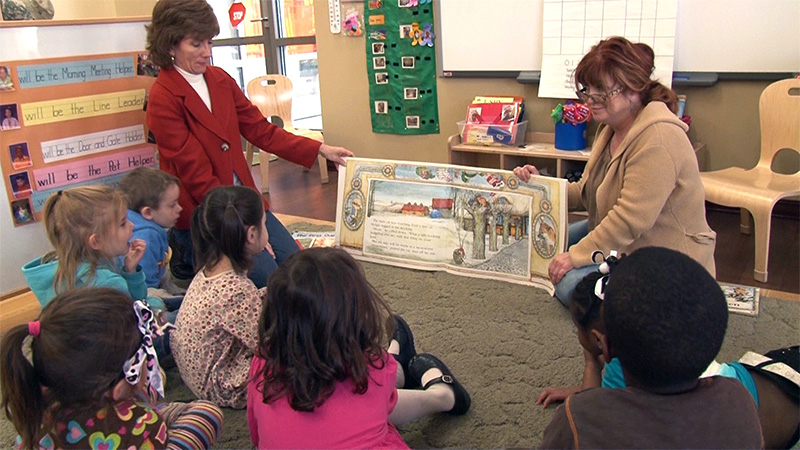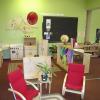- Ensure that staff members know the components of an effective schedule for the age group with which they are working.
- Model strategies for providing structured, yet flexible, schedules during interactions with adults.
- Manage and provide feedback on schedules and routines.
Learn
Know
Creating an effective schedule is like putting together a favorite recipe. There are certain ingredients, or elements, that go into an effective schedule. The order and style of those elements will be unique to each staff member. As with some recipes, there is room for flexibility. Ingredients can be changed or adapted based on individual needs. The key to an effective schedule is structure and flexibility (Chung, Gannett, La Perla, 2001).
Across all age groups, a substantial portion of the programming day should be dedicated to free-choice time. It is important to provide adequate time for children to engage in free-choice, unstructured activities. For school-age children, most of their school day is highly structured, so free-choice can be an important time to unwind and choose enjoyable activities on their own or with friends.
In most programs, some form of adult-guided large-group time occurs. In child-development programs, this can be a chance to read stories to the group, discuss the daily schedule, introduce new concepts, and build classroom community. Although important events can take place during large group time, it should be kept short. Young children learn best if group times are 15 to 20 minutes or less (Hemmeter, Ostrosky, Artman, & Kinder, 2008). For infants and toddlers, mandatory adult-directed activities are not developmentally appropriate, however staff members can still offer “a group time” as a way to strengthen their classroom community, asking the children to come together to share songs or ideas (e.g., copying the motions suggested by infants and toddlers; Lang et al., 2010). Infants and toddlers should be able to be active participants during group time, which should be short—5 to 10 minutes. It is appropriate to offer infants and toddlers the choice to engage in this time, and to offer stories, songs, or group activities with an adult and small group of peers at different points throughout the day. In school-age programs, adult-directed activities may be optional and may take a variety of forms: an opportunity to learn how to build model airplanes, a science experiment, or a structured outing. School-age programs may also offer a variety of optional group activities like acting out a play, doing community service work, or playing sports.

Supervise & Support
You are the manager of your program, so you have a unique opportunity to model effective scheduling. Think about how staff meetings are organized and managed; work with your trainers or coaches to make sure staff meetings reflect your program’s commitment to structured, yet flexible, schedules. Make sure staff members receive an agenda before the meetings and that meetings always begin and end on time. Make sure mechanisms are in place for staff members to share their needs and opinions related to staff meetings (e.g., a space where staff members write ideas or questions on sticky notes to be read at the end of the meeting, or an anonymous feedback box). Also, use the concepts from this lesson when or if you provide group professional development events: Provide a mix of activities, let participants know what the schedule will be (and when restroom breaks and meals are), and be responsive to the feedback participants give you verbally and through body language. If adults look bored, it’s time to make a change.
Provide new staff members with sample schedules they can use as models for creating their own learning experiences for children. Make arrangements for them to visit other classrooms or programs for ideas. Make sure staff members know that they need to communicate their schedules with children and with adults. That is, they will always need to create two schedules: a simple one appropriate for the children in their care and a more detailed schedule for other staff members or families.
You should have a copy of the classroom or program schedule for each of your classrooms and programs. With the help of your trainers and coaches, you should make sure the schedules outlined meet the expectations of your program (e.g., ample free-choice time, individualized for infants, etc.). Work with your trainers and coaches to make sure that staff generally follow the schedule they’ve created, following the sequence more than the clock time. Ensure that the schedules outlined in each classroom work with the staffing schedules you develop (it may be difficult to conduct small-group activities in the morning before all the classroom staff have arrived). With the help of your trainers or coaches, negotiate when you can with staff members to make both their individually developed classroom schedules and the larger staffing schedule of your program work together. The typical drop off and pick-up times for families in each classroom or program may very slightly, so work with staff to see when coverage is needed, or when you may be able to combine classrooms, again, staying sensitive to what staff know about the children and families they have contact with every day.
Also, follow your service operational procedures or developed program standards regarding staff work hours and breaks. Remember that just as children may need some private moments throughout their day to support their emotional regulation and productive engagement, your staff members should have appropriate breaks to take some moments for themselves to recoup before rejoining the children or youth. It is important, for children and staff alike, to ensure that these breaks happen, and as discussed in Lesson Two, staff members have comfortable spaces for their break time.
With help from your trainers and coaches, it is also important to find some time in staff members’ weekly schedules for them to do curriculum planning as a classroom or program, or perhaps some time for lead teachers to work on child assessments or portfolios. With the help of your trainers, coaches, substitutes, or perhaps through creative scheduling during nap times (e.g., shifting a staff member to another classroom temporarily), you can give each teaching or caregiving team the time they need to work on curriculum and activity plans for the upcoming week. Scheduling this time sends a strong message that you value staff members as professionals, that you want to give them the time to develop high-quality experiences for the children or youth in their care.
Examples of Schedules and Routines
Watch this video for examples of how routines and schedules support children at different points in development.
Management: A Range of Schedules and Routines
Explore
In your work as a manager, you may come across issues with balancing individual staff members’ scheduling requests, or the needs and schedules of individual classrooms, and the larger staff schedule of your whole program. Download and print the Scheduling Scenarios activity. Read the scenarios and decide how you would respond. Then, compare your answers to the suggested responses.
Apply
The Scheduling Puzzle is a helpful resource for you, trainers, or coaches to support staff members who are struggling with their schedules. Follow the instructions provided in the activity to help staff members identify issues and brainstorm solutions. TThis activity can also be done with your entire team, to evaluate trends in how time is spent in your program.
Use the Schedules and Routines Best Practices Checklist to reflect more on how schedules are used in your program.
Glossary
Demonstrate
Chung, A., Gannett, E., & La Perla, A. A. (2001). After-School programs: From vision to reality. http://www.thirteen.org/edonline/concept2class/afterschool/index.html
Harms, T., Cryer, D., Clifford, R. M., & Yazejian, N. (2019). Family child care environment rating Scale (FCCERS-3). New York: Teachers College Press.
Harms, T., Cryer, D. & Clifford, R. M. (2014). Early childhood environment rating scale (ECERS-3). New York: Teachers College Press.
Harms, T., Cryer, D., Clifford, R. M., & Yazejian, N.. (2017). Infant/Toddler environment rating scale (ITERS-3). New York: Teachers College Press.
Harms, T., Jacobs, E. V. & White, D. R. (2013). School-Age care environment rating scale updated (SACERS). New York: Teachers College Press.
Creative Curriculum Solutions. (n.d.). Teaching strategies. https://teachingstrategies.com/product/the-creative-curriculum-for-preschool/
Feldman, J. (1995). Transition time: Let’s do something different. Lewisville, NC: Gryphon House.
Feldman, J. (2000). Transition tips and tricks for teachers. Lewisville, NC: Gryphon House.
Hemmeter, M. L., Ostrosky, M., Artman, K., & Kinder, K. (2008). Moving right along: Planning transitions to prevent challenging behavior. Young Children, 63, 18-25.
Hemmeter, M. L., Ostrosky, M, & Fox, L. (2021). Unpacking the pyramid model. Baltimore, MD: Brookes Publishing Co.
Lang, S. N., Aledia, T., Casey, K., & Kirkbride, K. (2010, April). Infant/toddler group time: A time for creating & sustaining classroom culture. Presentation at Ohio Early Care & Education Conference, Columbus, Ohio.
Larson, N., Henthorne, M., & Plum, B. (2002). Transition magician. St. Paul, MN: Redleaf Press.
Lentini, R., Vaughn, B. J., Fox, L. (2004). Routine-Based support guide for young children with challenging behavior. Tampa, FL: University of South Florida, Early Intervention Positive Behavior Support. http://www.challengingbehavior.org/do/resources/teaching_tools/toc/folder1/1e_routine_based.pdf
National Institute on Out-of-School Time, Wellesley Centers for Women at Wellesley College. (n.d.).http://www.niost.org/


